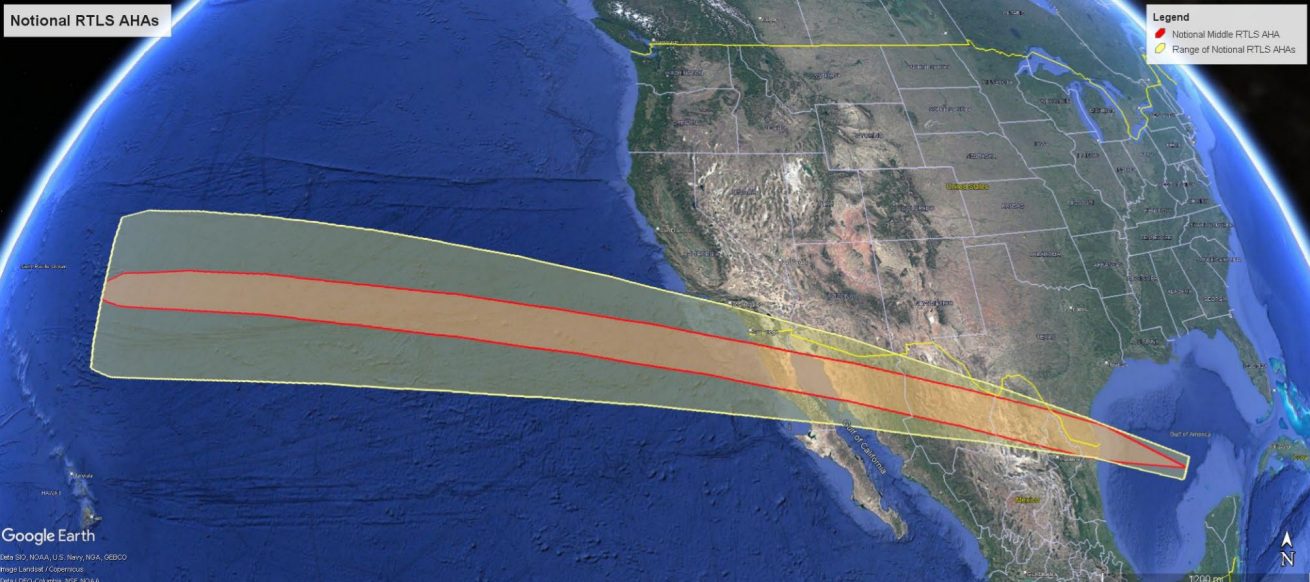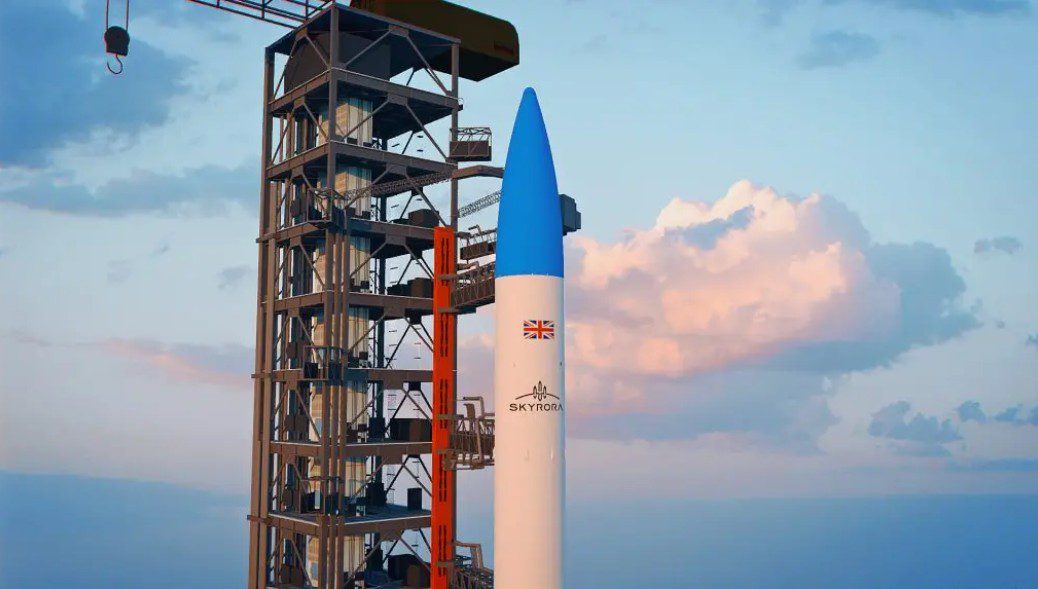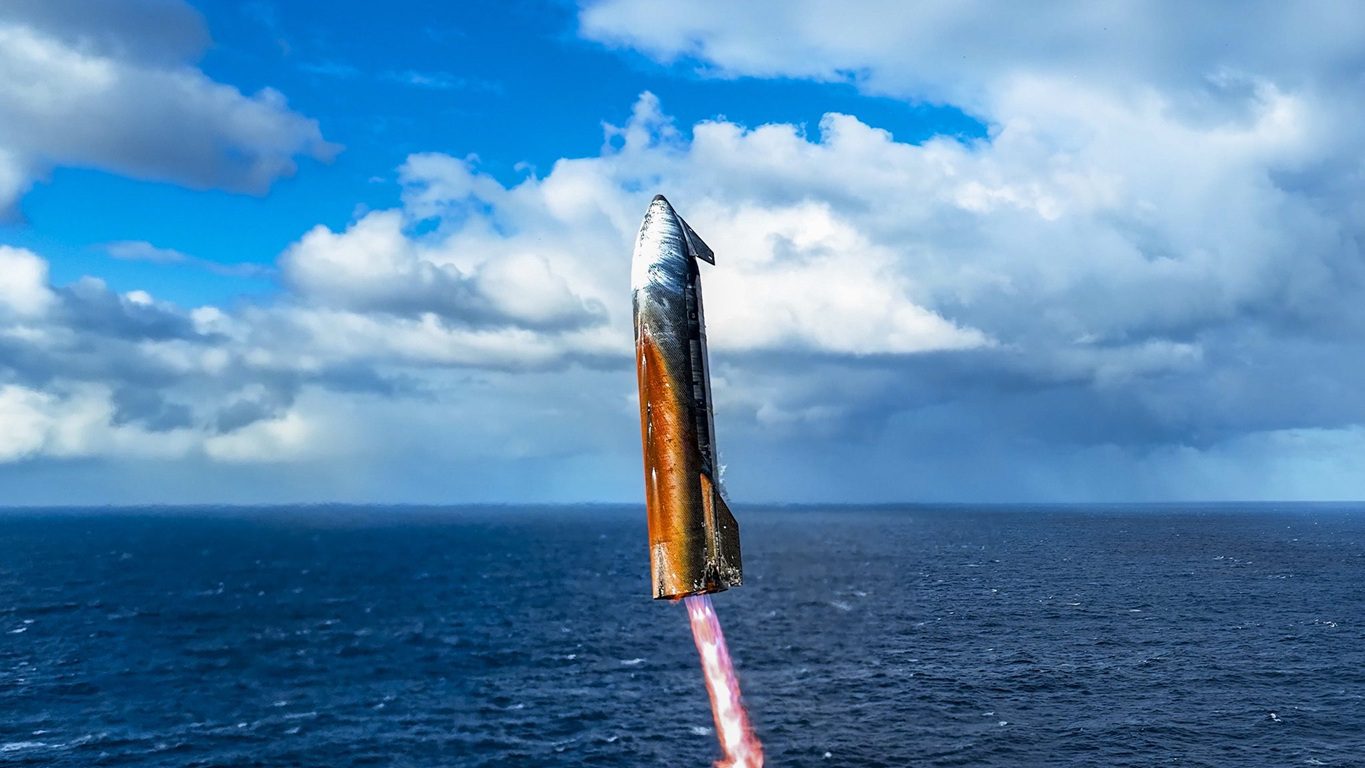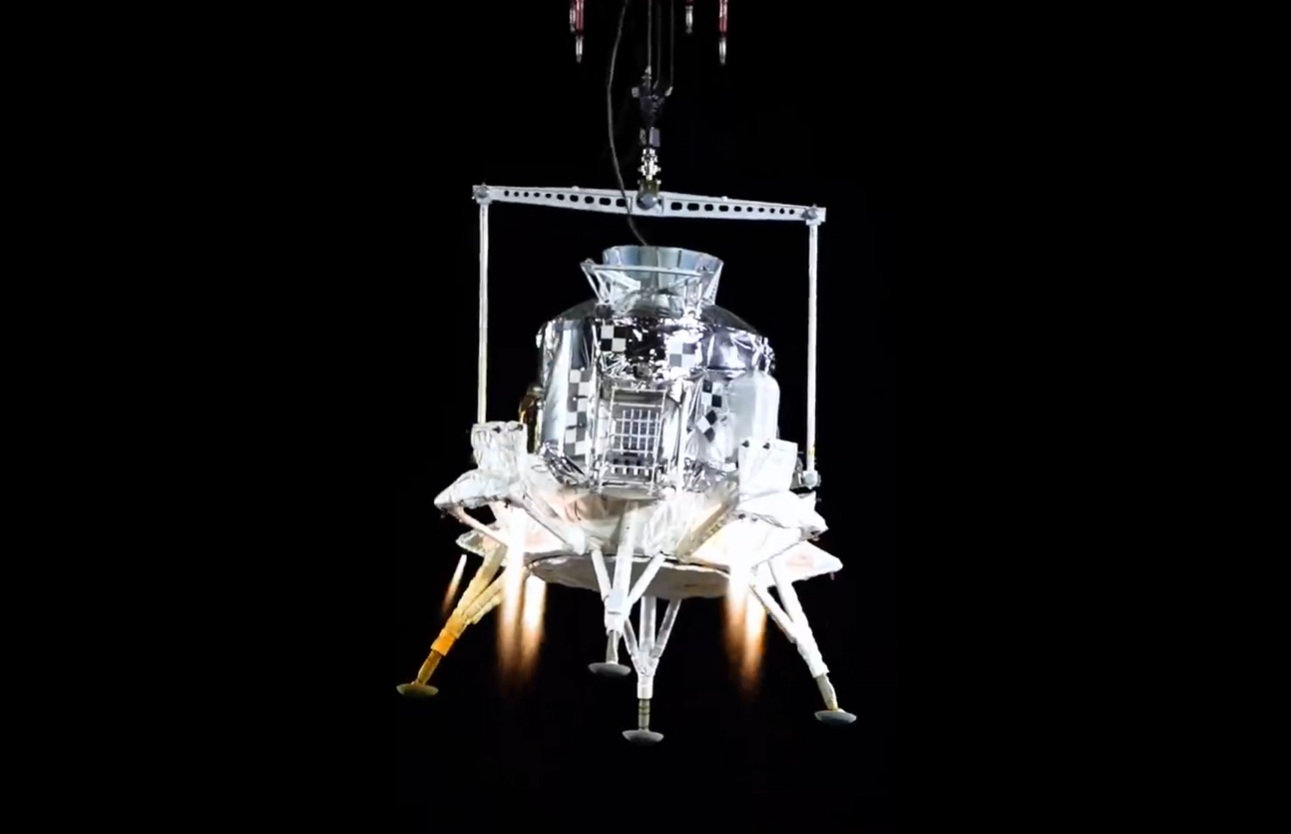On 13 February 2013, the Raytheon Company announced that its Standard Missile SM-3 Block 1A was fired from the USS Lake Erie and successfully destroyed a medium-range ballistic missile (MRBM) target using tracking data from two Space Tracking and Surveillance System-Demonstrator (STSS-D) satellites in low Earth orbit carrying sensor payloads able to detect infrared and visible light. The MRBM target was launched from the Pacific Missile Range Facility. As it rose above the horizon, the target was acquired and tracked by STSS-D. Threat data was then relayed through the Command, Control, Battle Management and Communications (C2BMC) system to the ship. The ship’s crew fired the SM-3 based on STSS track data and before the ship’s radar acquired the target.
“STSS-D’s unique vantage point in space allows the sensor payload to see the threat early in its trajectory and provide launch quality data sooner than nearly any other option,” said Bill Hart, vice president of Space Systems for Raytheon’s Space and Airborne Systems business. “We can give our naval warfighters extra time to analyze and respond, by providing target data before the ship can track the threat. That’s a tremendous advantage.”
This test result – the 21st success according to Raytheon is encouraging and adds to the overall programme successes (for the actual missiles there have been 24 intercepts out of 29 attempts).
However, it is usually only the test of battle that counts. And sometimes the truth about battle performance only comes out after the public relations team has done its business.
Over praised missile effectiveness: getting the missile but not the warhead
For example, it was only in action that it was found that the US Navy’s anti-aircraft and missile systems (including earlier versions of the Standard Missile) had a tendency to intercept the US Navy’s own “chaff” (foil strip) clouds dispensed to confuse enemy radars and missile systems rather than their own.
Likewise, in the first Gulf war of 1991, the Patriot missile system was claimed by the then U.S. President George H.W. Bush, to have shot down 41 out of 42 Scud-type missiles aimed at. Later, an independent analysis, now generally accepted, found that the missile system had had much less success with missed intercepts and missiles not killing the important part of the target: the warhead. Due to the high speeds involved, the Patriot missile’s proximity fusing was not fast enough to ignite before the Scud missiles had largely passed resulting in the Scud warhead surviving to explode on Earth. (Note: the accuracy of independent anti-missile strike analysis is not always accepted as happened recently when the effectiveness of Israel’s David’s Sling short range anti-missile system was controversially questioned).
At least post-Gulf War Scud missile effectivness analysis became public domain relatively quickly. After the Falkands war in 1982, the glowing report for British Sea Harrier/Sidewinder (Lima version) missile combination masked the disinformation of the claimed effectiveness effectiveness of ship and land based anti-aircraft missile systems. A more detailed analysis of their claimed good interception results conducted later showed much more mixed results for these anti-aircraft missiles. While the Royal Navy’s Sea Dart* medium range missile (8 kills out of 32 shots) worked acceptably and the Sea Wolf close range missile worked very well (3 kills plus one manoeuvre kill out of 8 shots) – the occasional computer hang up and satellite communications interference aside – nevertheless, some of the other missiles performed poorly in the Falklands conflict.
This list included an especially woeful performance of the then recently introduced British Army Rapier missile system against low flying Argentinian fighter bombers. Its poor results (only one aircraft confirmed as shot down in 60+ attempts) were covered up after the war as the UK missile industry was trying to market the Rapier at the time. Part of the Rapier’s problem was that it had no proximity fuse fitted meaning that always had to hit a target to achieve a kill. Proximity fuses have since been fitted to Rapier.
* The Sea Dart later added to its reputation by managing to shoot down an Iraqi Silkworm anti-ship missile aimed at the USS Missouri battleship during the first Gulf War in 1991.
Sea Cat missiles were only scary rather than effective and needed too much skill
It was not just the Army’s Rapier that failed to perform in the Falklands War. Perhaps a little more understandably, the Royal Navy’s venerable 1960s-vintage subsonic Sea Cat missile system (Seacat) also failed to make an impact (excuse the pun). It was deployed as the main missile defence in San Carlos Water (“Bomb Alley”) where amphibious landings were taking place mainly because it was not as dependent on radar as other missile systems which could easily be confused by returns from the nearby terrain. In not being an infra-red heat-seeking type it could also engage on coming aircraft and not be seduced by flares. However, despite claims that it shot down eight aircraft, detailed analysis after the war showed that while it had several claims, out of 80 Sea Cat missiles fired, only confirmed “kill” was achieved – an A4 Skyhawk shot down by a Sea Cat missile fired by HMS Yarmouth.
Trying to guide a Sea Cat missile manually towards a fast manoeuvring target at a distance, even with the benefit of binoculars and aided by flares on the back of the missile, proved too difficult for most. While later versions had radar-cueing and tracking with a technical blind fire capability, Sea Cat, for the most part, remained just a sort of rocket-powered radio-controlled aeroplane manually flown by a thumb joystick. As such the Sea Cat missile had deserved a reputation for being very difficult to fly and the best of its “missile men” became an admired cadre in the Royal Navy. A video clip of how the system worked is available here.
While making Sea Cat hits even against on-coming slow non-manoeuvring targets was difficult to achieve, the missile did at least have a proximity fused explosive warhead and a minimum height limiter to stop the missiles flying into the sea. Dealing with on-coming targets was one thing, but the Sea Cat missile was usually too slow at Mach 0.9 to catch up with a receding or crossing target. In having to accelerate from a standing start, and in having a range of only 5km, Sea Cat’s lack of speed and persistence meant that it could normally be outrun by an aircraft flying at 500kts, leaving the expended missile to forlornly fallaway into the sea, or self explode when its timer ran out.
There were claims of other Sea Cat damage made to other aircraft during the Falklands conflict, and a claim that one possibly even deflected an Exocet sea-skimming missile. A close pass by a non-detonating Sea Cat, combined with a rapid leaning turn by the ship itself, is claimed to have deflected the Exocet into the hanger of HMS Glamorgan rather than into its side. Nevertheless, by the end of the conflict it became apparent that Sea Cat as a first generation naval missile system was just too long in the tooth and too ineffective to carry on with. Soon after the Falklands war these venerable missiles were slowly removed from service by the Royal Navy. For example, during HMS Glamorgan’s post Falklands refit, her Sea Cat launchers were replaced by fitting more 20mm and 40mm guns.
While its thumb joystick controlled Shorts-stablemate, the shoulder-launched MANPAD Blowpipe missile, again needed too much skill, it was at least supersonic and had proximity fusing. It similarly had trouble in not having enough staying power to cope with crossing targets. But in the right hands it could be effective. The best operators learned to allow a bit of “lead” – that is to aim initially ahead of the passing aircraft at launch and then move the missile back onto the target – to improve their chances at shooting down a crossing aircraft. Out of 100+ shots, the Blowpipe (which both the British and Argentinian land forces operated) shot down five aircraft including helicopters albeit that only two of these – an RAF Harrier GR3 and an Argentinian Aermacchi MB-339 – could be classed as “fast jets”.
What they should have had: optically aimed Pom-pom guns (or the Bofors L70)
Having noted its relative failure, Sea Cat did, at least, gain a better reputation during the Falklands war for its ready-to-go reliability, and unlike other more modern systems including Sea Wolf, rarely failed to fire when commanded to do so. Likewise, while its strike rate remained low, it was later reported by Argentine pilots as being an effective “scare” weapon when fired at an on-coming aircraft.
Nevertheless, with the benefit of hindsight, it is difficult not to conclude that a World War II Royal Navy destroyer with its short range anti-aircraft armament of a quad 40mm (two pounder) Pom-pom, whose four guns could each fire at about 115 shells a minute (a total of 460 shells per minute), backed up by additional 20mm Oerlikon guns, would have survived better in “Bomb Alley” littoral environment than their modern nearly missile-only destroyer and frigate counterparts. It thus became more than a little obvious that instead of Sea Cat, it would have been better to have deployed more gun defences to try to shoot down, or at least put off, attacking jets.
At the very least, analysis of the Sea Cat missile’s relative lack of success, especially against fast crossing or receding targets, showed that it would have at least been more cost-effective to have used more anti-aircraft guns to create gun World War II Pom-pom gun-style barrages using time-fused and proximity-fused shells, and ideally, with tracer shells as well.
In fact, the Royal Navy did still field a few slow-firing (115 rounds per minute) 40mm L60 Bofors guns (the lighter, ballistically better, albeit slower firing successor to the Royal Navy’s well regarded wartime quad Pom-pom emplacement), plus some faster firing (480 rounds per minute) 20mm single Oerlikon guns on its warships, and of course some main 4.5 inch guns.
There were also a variety of small arms rapidly pressed into service as auxiliary anti-aircraft guns in the Falklands conflict including bullet firing .50 calibre Browning and 7.62m GPMG machine guns as well as SLR rifles (some modified for full machine-gun automatic fire).
Shooting parties of sailors and marines armed with these did at least put the Argentine pilots off their aim as their glowing trails of their tracer bullets whizzed past their cockpits. And while they did not have the “knock down” power of a proper anti-aircraft gun, in the event, they did manage to damage some aircraft. Meanwhile the 40mm and 20mm gun crews actually shot down two jet aircraft – one more confirmed kill than the much more expensive Sea Cat missile system.
In restrospect, instead of Sea Cat, the Royal Navy should have fielded the more up-to-date Bofors L70 gun on the Italian Breda large magazine capacity mount. Such guns had better ballistic characteristics than the L60 and fired at more than twice times the firing rate (up to 300 rounds per minute). With two such guns Royal Navy frigates or destroyers could have at least matched the volume of fire of their World War II predecessors with their quad Pom-pom gun emplacements.
Argentinian land forces had even better gun equipment with their Skyguard radar-guided twin Oerlikon fast firing (550 rounds per minute) 35mm guns which accounted for a Sea Harrier and an RAF Harrier GR3 being shot down, presumably in less radar terrain-hindered areas. Unfortunately for Argentina, their effectiveness was not constrained to just “enemy” aircraft and they also shot down two of their own.
Argentina did try and shot down British aircraft with two missile systems – the Roland shot down a Sea Harrier at 10,000feet. But the land based version of the Sea Cat, the Tiger Cat, which was being operated by Argentina has a flew near misses but failed to shoot down any aircraft.
Despite anti-aircraft guns’ limited successes – and greater cost-effectiveness than some missile systems – it should be realised that guns of 20mm or even 40mm calibre cannot usually prevent ships being bombed, as the US Navy found when trying to counter Japan’s Kamikaze suicide pilot attacks in World War II. For while a few 20mm explosive cannon shells or even just a single 40mm Bofors or Pom-Pom one would normally be able enough to shoot down an aircraft (or missile), such shells could not be guaranteed to destroy an attacking aircraft before it reaches a defended ship and even then a Kamikaze aircraft with its wings shot off might still reach it ballistic flight. Despite this limitation, after the Falklands conflict there was an air defence gun renaissance. Noting that guns would have to make the point defence kill more certain, Swedish manufacturer, Bofors, went on to perfect its fast firing, if large, 57mm dual-purpose guns which really do have an aircraft “knock down” capability.
The Royal Navy decided instead to replace Sea Cat with either Sea Wolf missiles or with more fast firing 20mm and especially 30mm guns, some of which were radar guided and very fast firing (e.g. Goalkeeper, Phalanx which fire at up to 4,000 rounds per minute).
By the way, the reason for the increasing popularity of 30mm and 35mm as gun calibres is that they are a sort of half-way-house between 20mm and 40mm. They are relatively light gun systems (important for ship top-weight stability limitations) but have shells large enough to allow a high chance of aircraft destruction in the event of a hit (even if it is after the aircraft has dropped its bomb), while firing them at high enough rates to give an increased chance of such a hit. In effect, they have become finally become worthy Pom-Pom gun replacements.
Missiles still better over blue water and at longer ranges
While guns are the usually the best “last ditch” defence, missiles remain the core of naval anti-air weaponry. When working correctly, missiles are usually much more effective than guns at destroying aircraft at short range, and are most definitely superior at longer ranges, and at high altitudes. Radar-guided missiles have also proven their anti-missile capability. For example, a semi-active radar guided Greek Navy Sea Sparrow missile successfully intercepted an Exocet sea-skimming missile during a firing exercise in 2012.
Nevertheless, analysis of actual engagements involving such sea-skimming anti-ship missiles has shown that soft-kill measures such as chaff and other decoys, are usually better than solely relying on a missile interception “hard kill”.
As already mentioned, chaff has the downside of sometimes confuse a ships own radar guided gun and missile defences. This happened when in the Gulf War in 1991 when a US Navy escort vessel opened fire on the battleship USS Missouri with its radar guided 20mm Phalanx system after it was seduced into firing on the battleship’s own deployed chaff. It had released this because a Silkworm missile was inbound. Thankfully there were no casualties and, as already mentioned, the Silkworm was then shot down by HMS Gloucester’s Sea Dart.
What they should have had: ground terrain can stop radar-guided missiles but heat seekers still work
Apart from being able to be decoyed, the other weakness of missiles is that they work best over open water. In the Falklands, the special “enclosed” nature of San Carlos Water landing zone which was surrounded by high ground had the benefit for the Royal Navy that that the radar guided anti-ship missiles of the time (Exocet) could not be used against its warships anchored there. The downside however was that the same same terrain also meant that radar-guided defence weapons, including even the Royal Navy’s the excellent new missile, the canister-fired radar guided Sea Wolf, had problems with their radars being confused/fogged by ground clutter. As it was, the hilly setting also allowed skilful Argentine pilots to mount jinking ground-hugging low level bombing runs making it even more difficult to shoot them down.
It was symptomatic that the the radar-cued “blind fire” GWS-22 and -24 versions of the venerable Sea Cat which could theoretically even work at night, worked less well in these enclosed circumstances compared to its GWS-20 manually aimed and controlled version which was still fielded by the older frigates in the conflict. As it was, while the modern radar versions of Sea Cat did theoretically have manually aimed and controlled back up, there there was often too little time to hand over control when a radar tracking solution could not be found. The missile aimer and his crewmates on the subsequently sunk Type 21 frigate HMS Ardent found this out to their cost during an air attack by Argentinian Navy A-4Q Skyhawks.
The alternative to terrain-hindered radar-guided missiles (and radar-laid guns) in such locations is to use guns, either directly aimed or aimed via an optical director.
In some ways the Soviet Navy was ahead of the game when it came to Close In Weapon Systems (CIWS). As a back up to their surface to air missiles, Kresta II and Kara-class cruisers of the period had four turrets, each carrying a AK-630 30mm Gatling gun capable of firing thousands of rounds per minute, and all aimed either by radar or optically by a human director. These well armed ships also had 57mm or 76mm guns as a further insurance.
As already discussed, guns are, of course, really a last chance short range defence at sub-1km ranges and it is missiles which usually have the longer reach and greater lethality. So what missiles would have worked in San Carlos Water?
With the benefit of hindsight, supersonic infra-red heat seeking “fire and forget” missiles such as either the Stinger and, even better, the very much underrated Raytheon Sidewinder-based Sea Chaparral would have worked better than either Sea Cat or Rapier in “Bomb Alley”.
Despite being a stand-in missile after Mauler missile programme was cancelled by the US Department of Defense, Chaparral has proven to be effective and had already shot down aircraft by 1982. The land-based version of Chaparral had its first kill when a Syrian Mig-17 was shot down by the Israel Defence Force over the Golan Heights in the Yom Kippur War of October 1973 and has since had reported successes in wars in Africa. With its 9km range and with a supersonic it had the staying power to chase down and catch a fleeing target. The Sea Chaparral version is still used by the Taiwanese Navy’s Kang Ding-class frigates, although these are now being replaced on these by more modern vertically launched radar guided missiles which have a longer reach. Sea Chaparral will however soldier on as a still-effective simple-to-operate anti-aircraft system on secondary naval ships such as Taiwan’s Panshih fleet supply ship, and its older Wu Yi stablemate.
Heat seekers are actually ideal for less sophisticated fighting forces as they are usually very easy to use: once fired it is the missile that does all of the guidance work. Modern short range missile systems still use infra-red guidance including the US/German RAM missile system (which is backed up by passive radar seeking). Likewise so does the French Mistral.
Later versions of the Chaparral missile even had a all-aspect capability via an improved seeker along with more resistance to flare decoys and ground thermal interference. Nevertheless, supersonic heat-seeking missiles such as Chaparral and Stinger generally work best in a tail-chase mode.
Of course, the downside of such tail-chasers, and probably the reason why the Royal Navy chose the directly controlled Sea Cat for point defence, is that they are more of a “revenge weapon” rather than an effective preventative measure against attack. This is even more apparent when such systems are not radar-cued and rely on the human eyeball to make the initial contact – often after the aircraft has made its attacking pass. Worse, the less sophisticated versions can also be easily deflected by decoy flares.
However, while they would not have had the scare effect of an oncoming Sea Cat or an anti-aircraft artillery barrage, supersonic tail-chase types like Chaparral are at least fast enough to get the enemy jets as they fly away or fly by as a crossing target. And by positioning Sea Chaparral-armed ships in San Carlos correctly, they could have each given cover for each other.
What they should have had: guns to fire at them on the way in, heat seakers to shoot them down on the way out
Ideally then the Royal Navy should have had AA guns to oppose the Argentine jets with a barrage on the way in, and Sea Chaparrals to shoot them down on the way out. If fast firing guns and Sea Chapperals had been deployed in large numbers in the Falklands (both at sea and on land), instead of the ineffective Rapiers and elderly Sea Cats, then they could have caused the Argentinian air force and navy pilots to suffer a much higher attrition rate than they actually did. However, that probable scenario is with the benefit of 20:20 hindsight.
Having said that, perhaps the Argentinians might have sunk more ships with their bombs if they had armed them correctly for low level release. Many did not explode even after striking a ship. In total the Royal Navy lost four of its warships to Exocet missile and air attack but it could so easily have been so many more given the number of ships which were actually hit.
A new missile age for Indonesia: venerable Sea Cat is retired as Yakhont supersonic cruise missiles arrive
It is noticeable that the last operator of the Sea Cat missile, the Indonesian Navy, is now replacing them on their elderly Anglo-Dutch Van Speijk-class frigates with more modern Mistral all-aspect infra-red seeking missiles which are self guided if initially manually aimed from two-round Simbad launchers. Mistral, as an easy-to-operate point defence missile which is not affected by radar clutter issues. It is precisely the sort of missile that would have been ideal to defend the San Carlos landings in 1982 had it been available.
While the simple short range Mistral missile is a logical and cost-effective choice for the navy of a developing nation like Indonesia, somewhat surprisingly, alongside these modest missiles and their soon-to-be retired near-antique Sea Cats, Indonesia’s elderly Van Speijk-class frigates also carry four highly sophisticated Yakhont supersonic anti-ship missiles to attack other ships with. These Russian-built Yakhonts (like the Brahmos Indian-built copy), are regarded a state-of-the-art anti-ship missiles. As such, the Yakhont has now become a scare-word for Western navies.
With a reach of 300km and a supersonic cruise capability, it would be difficult to intercept especially if fired in a multi-missile salvo. Yakhont really needs satellites and/or maritime aircraft targeting updates to be effective when launched to over-the-horizon distances. While Indonesia does not really have a satellite ocean surveillance capability, it is known to be increasing its maritime patrol aircraft fleet. Indonesia, of course, is the nation with the longest coastline in the world.
Film of a test firing of Indonesia’s Yakhont missile is here: http://www.youtube.com/watch?v=JxrSOimGTJs
After Sea Cat, Sea Dart and Sea Wolf (later in a vertically-launched guise), the Royal Navy now moved on to a new generation of radar guided guided missiles to meet this new threat as well as other ones. Apart from planning a vertically launched short-to-medium range radar guided missile called Sea Ceptor (which also uses ASRAAM technology with an active radar seeker), the Royal Navy is already fielding Europe’s equivalent of the SM-3, the Aster 15/Aster 30 (aka Sea Viper) on board its otherwise under-armed Type 45 destroyers.
While these are being deployed mainly to counter supersonic aircraft and anti-ship missiles, the longer range Aster 30 version of the missile even has a basic anti-ballistic missile capability, and a newer version is planned to further improve on this aspect. It may be wise to do so this given reports that China recently tested its DF-21D “anti-aircraft-carrier” missile against a aircraft carrier-sized target in the Gobi desert. Meanwhile, Argentina is busy re-energising its ballistic missile programme which may yet have an anti-ship application.
And for shorter ranged defence against aircraft and missiles? Well guns are now viewed as “so last century”. And while it does have RAMS – a kind of modern infra-red and passive radar-seaking equivalent to the Sea Chaparral with a similar 9km range – the US Navy has reasoned that to beat a faster-than- sound missile it might need a speed of light weapon and has now begun deploying lasers as a last ditch defence against supersonic and even hypersonic missile attacks.
Update: In early March, the UK Ministry of Defence announced that it has agreed to allow a Royal Navy Type 45 destroyer demonstrate its Sampson tracking radar in tests conducted in conjunction with the US Missile Defence Agency (MDA) to see how well it can track ballistic missiles. In April, the US Navy successfully shot down a drone aircraft using a directed energy laser beam which is designed to be a last ditch defence against missiles and aircraft.
Post script (Updated on 24 August 2014): The manually-aimed version of the Sea Cat missile system, the GWS-20, armed HMS Plymouth. This Rothesay-class frigate is the last survivor of the Royal Navy ships which fought in the Falklands War and was a sister of HMS Yarmouth which did actually manage to shoot down a A4 Skyhawk using a Sea Cat missile during the conflict. Sadly, HMS Plymouth is now being scrapped after being a museum ship in Birkenhead, Liverpool.
Update on 6 September 2014: In an echo of the issues that the Patriot missile had, modern missile systems still have trouble getting the fusing right. The Israeli short range rocket defence Iron Dome is still under criticism for letting too many warheads through despite actually shooting down the great majority of the carrying ballistic rockets. The configuration of the laser triggered proximity fusing has been blamed.







